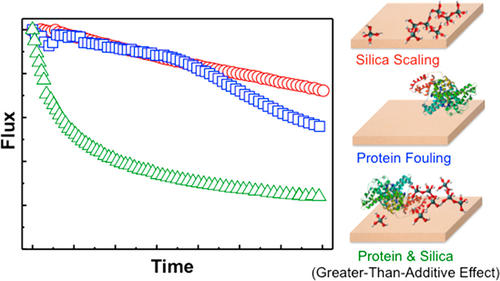
Research in the Elimelech lab continues to explore fundamental transport and scaling processes involved water treatment by reverse osmosis. This manuscript, written by lead author graduate student Amanda Quay, elucidates details of the interactions between proteins and silica in dirty feed water, and the manner in which they lead to membrane fouling.
Combined Organic Fouling and Inorganic Scaling in Reverse Osmosis: Role of Protein-Silica Interactions
AN Quay, T Tong, SM Hashmi, Y Zhou, S Zhao, M Elimelech
Abstract:
We investigated the relationship between silica scaling and protein fouling in reverse osmosis (RO). Flux decline caused by combined scaling and fouling was compared with those by individual scaling or fouling. Bovine serum albumin (BSA) and lysozyme (LYZ), two proteins with opposite charges at typical feedwater pH, were used as model protein foulants. Our results demonstrate that water flux decline was synergistically enhanced when silica and protein were both present in the feedwater. For example, flux decline after 500 min was far greater in combined silica scaling and BSA fouling experiments (55 ± 6% decline) than those caused by silica (11 ± 2% decline) or BSA (9 ± 1% decline) alone. Similar behavior was observed with silica and LYZ, suggesting that this synergistic effect was independent of protein charge. Membrane characterization by scanning electron microscopy and Fourier transform infrared spectroscopy revealed distinct foulant layers formed by BSA and LYZ in the presence of silica. A combination of dynamic light scattering, transmission electron microscopy , and energy dispersive X-ray spectroscopy analyses further suggested that BSA and LYZ facilitated the formation of aggregates with varied chemical compositions. As a result, BSA and LYZ were likely to play different roles in enhancing flux decline in combined scaling and fouling. Our study suggests that the coexistence of organic foulants, such as proteins, largely alters scaling behavior of silica, and that accurate prediction of RO performance requires careful consideration of foulant–scalant interactions.